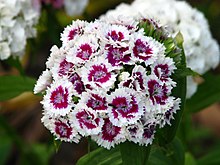| Dianthus barbatus | |
|---|---|

| |
| Scientific classification | |
| Kingdom: | Plantae |
| Clade: | Tracheophytes |
| Clade: | Angiosperms |
| Clade: | Eudicots |
| Order: | Caryophyllales |
| Family: | Caryophyllaceae |
| Genus: | Dianthus |
| Species: | D. barbatus
|
| Binomial name | |
| Dianthus barbatus | |
| Synonyms[1] | |
| |
Dianthus barbatus, the sweet William,[2] is a species of flowering plant in the family Caryophyllaceae, native to southern Europe and parts of Asia. It has become a popular ornamental garden plant. It is a herbaceous biennial or short-lived perennial plant growing to 13–92 cm tall, with flowers in a dense cluster of up to 30 at the top of the stems. Each flower is 2–3 cm diameter with five petals displaying serrated edges. Wild plants produce red flowers with a white base, but colours in cultivars range from white, pink, red, and purple to variegated patterns. The exact origin of its English common name is unknown but first appears in 1596 in botanist John Gerard's garden catalogue. The flowers are edible and may have medicinal properties.[citation needed] Sweet William attracts bees, birds, and butterflies.
- ^ "The Plant List: A Working List of All Plant Species". Retrieved 19 April 2015.
- ^ Thompson and Morgan plant catalog spelling – Sweet William